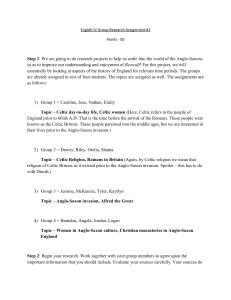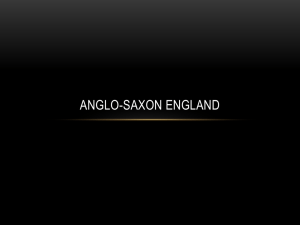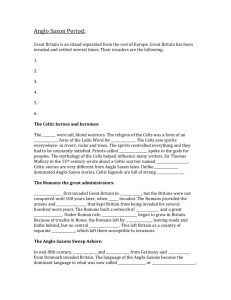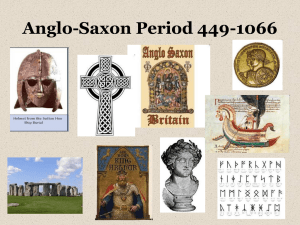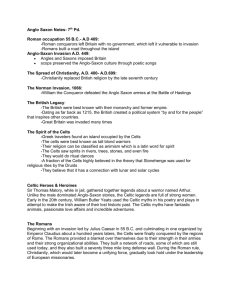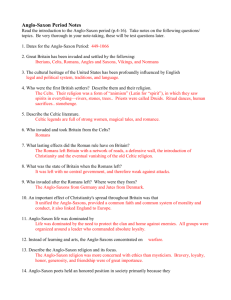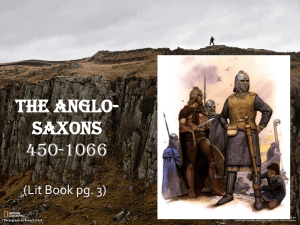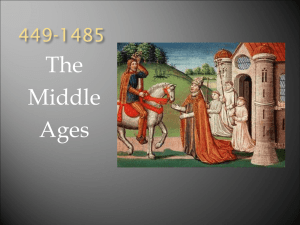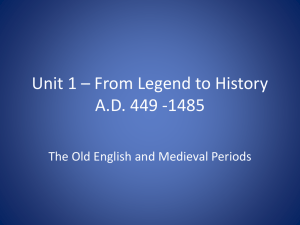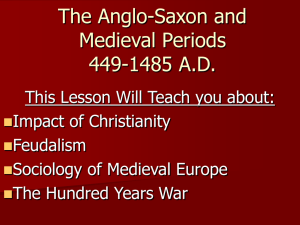The anglo-saxon era
advertisement
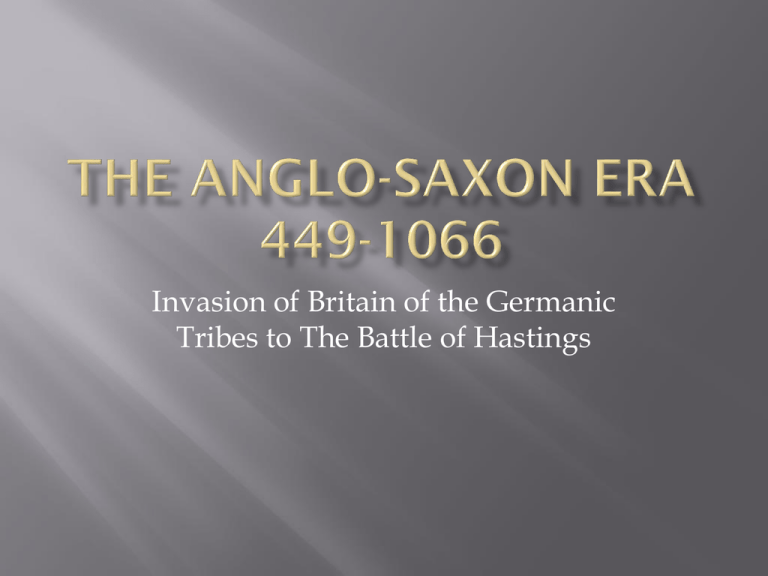
Invasion of Britain of the Germanic Tribes to The Battle of Hastings Since the time of the Magna Carta (1215), the English were creating a political system “by and for the people” America would not be what it is today without the legacy of English common law and its emphasis on personal rights and freedoms, English parliamentary government, English literature and the English language. Many of our language, literature and law concepts are in place due to the Anglo-Saxon period of British history. England, a small and isolated country, was first invaded and settled by the Iberians, then the Celts, the Romans, the Angles, Saxons, and Jutes, the Vikings and the Normans The name Britain comes from a group of Celts called the Brythons Celtic religion was called Animism (from the latin word for “spirit”)—Celts saw spirits everywhere Druids (Celtic priests) were intermediaries between the gods and people Gods and spirits must always be kept happy as a result ritual dances and even human sacrifices were sometimes practiced Stonehenge in Salisbury Plain in Whitshire may have been used by Druids for religious rites Celtic mythology influenced English and Irish writers Malory in the 15th Century gathered Celtic legends about a warrior named Arthur—Le Morte d’Arthur Arthur is the embodiment of English values In the 20th Century, William Butler Yeats used Celtic myths in an attempt to make the Irish aware of their lost heroic past Celtic myths are full of strong women, unlike the male dominated Anglo-Saxon literature Queen Maeve of Connacht: Irish story about a queen leading her troops into battle over the ownership of a white bull Celtic myths take the reader to enchanted lands where magic and imagination ruled. 55 BC—Julius Caesar led an invasion into Britain 100 years later and invasion organized by Claudius finally defeated the Britons The Roman occupation prevented further invasions for several hundred years Romans built a network of roads (some still used today) Romans built a defensive wall (Hadrian’s wall, 73 miles) Christianity gradually took hold under the leadership of European missionaries—old Celtic religion began to vanish By 409AD, the Romans returned home to battle barbarians leaving behind the infrastructure but no strong central government Without the Romans, Britain was a country of separate clans, resulting in weakness and making it ripe for invasion In the middle of the 5th Century, Angles and Saxons came from Germany, and the Jutes came from Denmark The Anglo-Saxon language became the dominant language in the new land-- Engla land (England) Celts fought hard before retreating to Wales in the west—traces of culture remained (”once and future king” King Arthur) At first the country was still divided into its own principalities each with its own king Under King Alfred the Great , England became a nation He unified the clans in order to fight off the invading Danes (Vikings) Christianity provided a common faith and common system of morality and right conduct Christianity also linked England to the rest of Europe Christianity spread largely due to Irish and continental missionaries—most important St. Augustine The Anglo-Saxons continued to fight to protect their people, their culture and their church Eventually, both the Anglo-Saxons AND the Danes were defeated in 1066 by William, Duke of Normandy (William the Conqueror) The Battle of Hastings (last battle in the Norman Conquest) The Anglo-Saxons were not barbarians but their lives were not filled with learning, the arts or luxurious living WARFARE was the order of the day Law and order was the responsibility of the leader or any given group or clan King was absolute ruler but still consulted with witan (wise men) Fame, success, and survival were gained through loyalty to the leader, especially during war Success was measured in gifts from the leader Loyalty grew out of need to protect the group from terrors in the wilderness Most Anglo-Saxons lived close to their animals in single family homesteads These wooden buildings surrounded a communal court (mead hall) or a warm, fire-lit chieftain’s hall This community arrangement contributed to a sense of security but also to the close relationship between leaders and followers It also encouraged community discussion and rule by consensus Women had rights in Anglo-Saxon society that were curtailed after the Norman Conquest Women inherited and held property, even after marriage Men were required to give a women a substantial gift before marriage: morgengifu or “morning-gift” Women became powerful abbesses in the religious community Hild, the abbess of Whitby, accumulated an immense library and turned Whitby into a center of learning Despite the influence of Christianity, the old Anglo-Saxon religion with warrior gods persisted Dark, fatalistic religion had come with the AngloSaxons from Germany and had much in common with Norse or Scandinavian mythology Wyrd was used by the Anglo-Saxons to represent one’s fate in life Lof-fame that survives death could be earned through heroic actions Anglo-Saxon Earthly Values: Bravery, Loyalty, Generosity, Friendship No afterlife NORSE Odin-god of death, poetry and magic Thunor (Thor)-god of thunder and lightning ANGLO-SAXON Woden (Woden’s Day =Wednesday) Thor (Thor’s Day=Thursday) The dragon-protector of treasure; seen as “death devourer” and guardian of the burial mound Anglo-Saxon religion seems to have been more concerned with ethics than with mysticism— with the earthly virtues of bravery, loyalty, generosity, and friendship Communal Hall or Mead Hall provided the arena for storytellers and audiences Storytellers were called bards or scops and sang to the strumming of a harp To the Anglo-Saxons creating poetry was as important as fighting, hunting, farming or loving Much of the literature was mournful or elegiac—focus on the fact that life is hard and ends in death Because Ireland was isolated and surrounded by wild seas, it was not overrun by the Germanic invaders Celtic Ireland was converted to Christianity in 432 by a Romanized Briton named Patrick From 432-750, Ireland experienced a Golden Age Irish monks founded monasteries that became sanctuaries of learning and refuge Bards, poets, scops provided one element of hope: the possibility that heroic deeds might be enshrined in society’s memory Christianity was another element of hope Monasteries served as centers of learning and preserved the Latin and Greek classics as well as great works of popular literature, such as Beowulf Scriptorium: writing room where monks would copy manuscripts by hand Latin was the language of the church and educated until King Alfred Because of King Alfred (Father of English Prose), English became a respected language thus bringing recognition to great works of literature in Old English The Anglo-Saxon Chronicle was commissioned by King Alfred and was a lengthy running history of the early days of England 1300BC Gilgamesh epic written down 55 BC Julius Caesar invades Britain 50Ad Londinium (present day London) founded by Romans— regained prominence with Alfred in 866 499 Angles, Saxons and Jutes invade Late 500s Books are printed in China 597 St. Augustine(first Archbishop) converts AngloSaxon King Ethelbert and establishes monastery at Canterbury 670 Caedmon, the earliest English Christian poet 730 The Venerable Bede write Ecclesiastical History of the English People know as the father of English history 760 Monks begin Book of Kells manuscript of the Latin Gospels (Matthew, Mark, Luke and John 793 Vikings invade beginning a century of war 871 Alfred the Great becomes king 975 The Exeter Book a collection of English poetry is first copied 1066 William the Conqueror defeats the Anglo-Saxons Map of British Isles: be able to identify Ireland, Scotland, Wales, England, France, London, Thames River United Kingdom =Scotland, England, Wales and Northern Ireland p.4 Hadrian’s Wall Photograph p. 5 Bayeux Tapestry— 20inches high and 230 feet long, commissioned by William the Conqueror to depict The Battle of Hastings p. 10 Anglo-Saxon Village Photograph p. 7 Stonehenge Photograph and description by Julius Caesar

